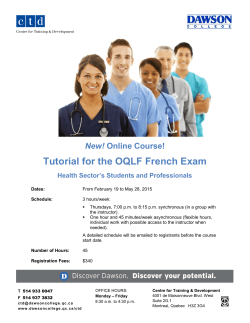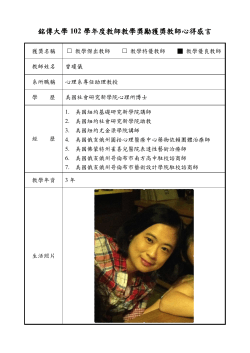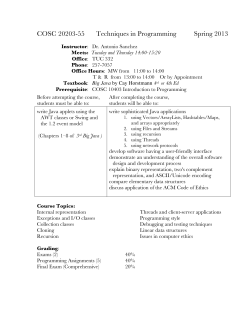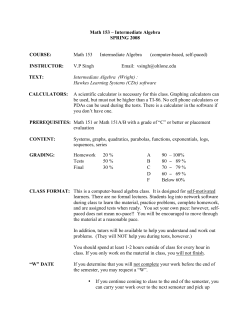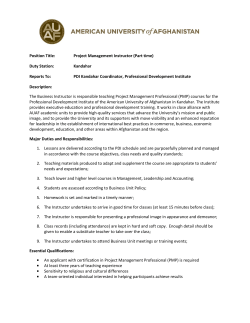
M 172 (Calculus II) Spring 2015 Instructor: Regina Souza
M 172 (Calculus II) Section 1 2 Spring 2015 MTWF 9 am 10 am Room MA 108 MA 103 Instructor: Regina Souza CRN 30048 30335 Math Learning Center (MLC) (http://cas.umt.edu/math/undergraduate/all-students/free-tutoring.php): Location: Room Math 011 (basement); Open: Mon–Thurs: 10–4pm, Friday: 10am-1pm Mansfield Library Main Floor; Sun–Thurs, 6:30–9pm Contact Information (for Dr. Souza) : Room MA 104, Phone: 243-2166, Email: Regina.Souza@umontana.edu Office Hours for Dr. Souza: Mo, We: 2:10-3pm, Tu, Fri: 11:10-12pm, or by appointment. Contact Information for the course coordinator Dr. McKinnie (http://www.math.umt.edu/mckinnie/) Text book: Calculus (Single Variable), 6th edition, by Hughes-Hallett, Gleason, McCallum, et al. Available online and at the UM bookstore. The price at the bookstore is quite competitive, so I would recommend checking it out. Graphing Calculator A graphing calculator is required. Class demos will be given with a TI-83 or TI-84. Calculators can be a useful tool for mathematics, making computations less tedious and aiding in exploration of sound mathematical intuition. However we must be careful, relying too heavily on calculators can hinder the development of reasoning, estimation, and mental mathematics skills. For these reasons, calculators may not be allowed or needed on certain quizzes and exams. Course Description Offered autumn and spring. Prereq., M 171 or 181. Techniques of Integration. Area computations. Improper integrals. Infinite series and various convergence tests. Power series. Taylor's Formula. Polar coordinates. Parametric curves. 4.0 Credit hours Learning Outcomes Upon completion of this course students will be able to: 1. Use the integral to find the area between two curves, volumes of revolution, work and the average value of a function; 2. Apply integration by direct and trigonometric substitution, parts, and partial fractions; 3. Calculate improper integrals and understand what it means for an integral to be improper; 4. Explain and apply parametrized curves in rectangular and polar coordinates, their derivatives, arc lengths and enclosed areas. 5. Use the integral to find arc length; 6. Explain and apply infinite sequences of real numbers, their monotonicity and boundedness, and the Monotonic Sequence Theorem; 7. Explain and apply convergent series of real numbers, geometric series, telescoping series, and the basic test for divergence; 8. Explain and apply the integral, comparison, limit comparison, and alternating series tests for series convergence; 9. Explain and apply absolute convergence and the ratio test; 10. Explain and apply power series, radius of convergence, and the integration and differentiation of power series; 11. Explain and apply Taylor series and Taylor polynomial approximation of functions; Grading Policies Your course grade will be based on 4 exams, a common final exam and other activities. Assignments Points and Percentages Four midterms (100 points each; Feb.13, Mar.6, Mar.27 & Apr.24) 400 points (50%) Other activities (homework, quizzes, reading assignments, etc…) 200 points (25%) Cumulative Final Exam (all sections Wed, May 13, 6-8 pm at NULH) 200 points (25%) By enrolling in this course it is understood that you will be present for the final exam. Since this is a common final there is no flexibility in this policy. Grading scale: 93% 90% A A 87% B+ 83% 80% 75% 70% 65% 62% 58% 55% 55% B C+ C D+ D F B C D Some Strategies to Complete This Course Successfully Regular attendance: give support to and get support from your classmates and instructor during class. Read the textbook both before and after the topics are covered in class: read the authors’ introductory remarks to get a feel for the material, take the reading assessment if your instructor provides one, or use the ``Check Your Understanding” problems at the end of each chapter. Redo examples on your own and then compare your solution with the authors’ approach. Read the ``Summary’’ or create your own summary before you start your homework. There will be a reading quiz on Moodle (due right before class). “Do math”: One of the best ways to learn mathematics is to do mathematics. We will have written homework (so you can practice writing down your reasoning) and, in order to have immediate feedback, we will have also online WeBWorK assignments (http://lennes.math.umt.edu/webwork2/). Expect at least 2 hours of work outside class every day. Get some one-to-one interaction: take advantage of your instructor’s regular office hours (also available by appointment), meet with tutors or with your classmates at the Math Learning Center (in the Math building, Room Math 011) or Math@Mansfield, create a study group or find a study partner. For some of us this is the most effective (and most fun) way to learn math. Find more information on Moodle ( https://login.umt.edu/cas/login). Policies for Make-up Exams and Some General University Policies Make-ups: Exam make-ups will be given only under special circumstances (illness, UM-sponsored travel, family emergency, etc.) Please make arrangements as soon as you know you will miss an exam. Early finals will not be given. If you feel your situation deserves special consideration, you will need the approval of the course coordinator. Disabilities: Students with disabilities are welcome to discuss accommodations with me. More information can be found at the website of the Disabilities Services for Students (DSS) (http://www.umt.edu/dss/). Disability Services now requires one week's notice for scheduling exams. Important Dates/Deadlines (see www.umt.edu/registrar/PDF/Spring2015RegistrationDeadlineChart.pdf): Petitions to drop between April 7 and May 8 must be approved by the Dean of the student’s major. Incompletes may be given only if a student has been in attendance and doing passing work up to 3 weeks before the end of the semester. See these and other policies in the student catalog (http://www.umt.edu/catalog/academics/academic-policy-procedure.php). Misconduct: All students must practice academic honesty. Academic misconduct is subject to an academic penalty by the course instructor and/or a disciplinary sanction by the University. See Student Conduct Code (http://www.umt.edu/vpsa/policies/student_conduct.php).
© Copyright 2025



